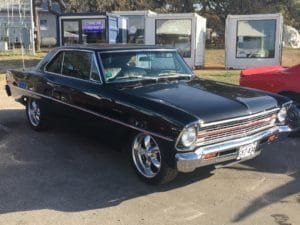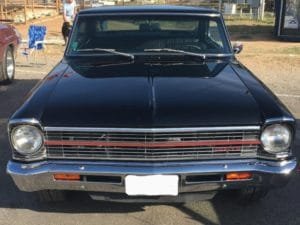Featured here is a very good looking 1967 Chevy Nova II.

The 67 was a part of Chevrolet Nova’s second generation which included the 67 and 68 model years. From the years 1962 through 1967 the automobile was officially a Chevy II and Nova was a trim level. The Nova trim level example was referred to as the Nova 400 but shortened for most purposes as just Nova. The Nova 400 models were the best selling of the Nova Chevy II. The 1967 Chevy II Nova 400 series was available as a two or four door sedan and a wagon.
Why Chevy Needed the Nova Model
The Nova began as a car that Chevrolet needed to compete against the new compact-car wars that were getting intense. The Nova was designed straight from the drawing board, not from any other car. The Nova was an entirely new design. Ford introduced the Falcon/Comet, Chrysler’s compact was the Valiant/Dart, AMC offered the Rambler American and Studebaker produced their Lark. Although Chevy already had a compact car with it’s Corvair, they needed an automobile that would compete with the new rear wheel drive compacts.
1967 Chevy Nova Styling
For the 1967 model year there was little changed from the previous year. What was changed included upholstery and trim plus the front fenders due to a change in the headlight bevels.
The 1967 model year, while having few styling changes, did usher in government mandated energy absorbing steering columns and steering wheels. Also the introduction of soft interior parts including armrests and sun visors plus recessed instrument panel knobs. Standard safety equipment also included front shoulder seat belt anchors.
The 1967 Chevy II Nova and the Chevy Camaro
When Chevrolet unveiled their Camaro model for 1967 there was an impact on the Chevy Nova II and all the Chevy II models.
The Camaro was positioned against the Ford Mustang and was built as a muscle car. Due to this the Turbo Fire 327 cubic inch 350 HP engine was discontinued on the Nova II offerings beginning in 1967. With that being said, the Nova II still had very good horsepower available as detailed below.
The 1967 Chevy Nova II production numbers were not nearly as good as those from 1966. In fact, production dropped by one third to 106,500. Much of this had to do with GM focusing on their new Camaro.
1967 Chevy Nova Specifications
Standard with the 1967 Chevrolet Nova was a 194 cubic inch inline six delivering 120 HP. In addition were options for more powerful engines. These were a 250 cubic inch inline six putting out 155 HP and two different V-8’s. A 283 cubic inch with 195 HP and a 327 cubic inch with 275 HP.
If the buyer wanted it, the high horsepower was available.
Transmissions included a three speed manual and a two speed automatic.
Brakes were four wheel hydraulic drums.
Dimensions include a wheelbase of 110.0 inches, outside overall length 163.0 inches, width 72.5 inches.
Related articles from Auto Museum Online are on the links below..
Reference material for this article includes..The Complete Book of Classic Chevrolet Muscle Cars: 1955-1974 (Complete Book Series) by Mike Mueller…Nova SS: Nova and Chevy II by Steve Statham..Muscle Cars:Kings of the Street From the Golden Era by the Editors of Consumer Guide.
The 1967 Chevy Nova II Collector Car
The years from 1963 to 1974 (first three generations) are the most popular Chevy II models with most collectors. The 1966 Nova SS might be the most popular of all.
The Chevy II offered the Nova as the name for the higher-end, sportier trim option. This is the trim level very popular with collectors and the trim level that suited some very powerful engines as described earlier. The second generation of which the 67 Nova is a part of was known as the time when bigger engines first appeared with the Nova.
Current asking prices for a 1967 Chevy II Nova in excellent and highly original can be found in a wide range from about $45,000 to $85,000. You may also find a few restomods at higher asking prices.
(Article and photos copyright Auto Museum Online)



